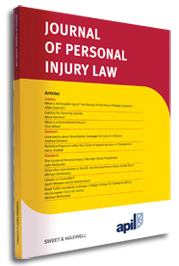Mitchell v News Group Newspapers Ltd [2013] EWCA Civ 1537
There can be very few civil litigation lawyers unaware of
Lord Dyson MR’s judgment in this case.
If any warning of the new post Jackson tough line were needed, it can
certainly be found here: stated in blunt terms.
This judgment, and in particular the guidance offered at paragraph 40
and following, is essential reading for anyone wishing to stay in business as a
civil litigator.
There is no need to recite the case facts here as a host of
commentators have done so at length. My own
analysis is published by Lexis Nexis in the BPILS Bulletin. I prefer to reflect on the lessons to be
drawn from this case.
CPR 3.9 requires a court to consider the need (i) for
litigation to be conducted efficiently and at proportionate cost and (ii) to
enforce compliance with rules, practice directions and court orders. The Court of Appeal held that these
considerations are of paramount concern.
This rule change reflects a deliberate shift of emphasis imposed by the
post-Jackson civil justice reforms.
Although CPR 3.9 requires the court to consider ‘all the circumstances of the case, so as to enable it to deal justly
with the application’ and although this is capable of including the other
factors listed in the earlier version of this rule ( e.g. whether the breach
was intentional, the applicant’s other conduct, whether relief was sought
promptly etc ) the two consideration listed above trump all other factors.
We are given useful guidance on how the courts will apply
CPR 3.9 at paragraphs 4o to 46 of the judgment.
If the breach is anything other than trivial then a heavy burden lies on
the defaulting party to persuade the court to grant the relief. Unless there is a very good reason (e.g.
serious illness or injury of the party’s solicitor or some other intervening
factor) then the presumption will be that the sanction imposed, whether by
court order or automatically under the rules, is appropriate and should not be
disturbed. Inadvertent default through
oversight or pressure of work are likely to be given scant regard, as these
salutary words from the judgment make clear: ‘Solicitors cannot take on too much work and expect to be able to
persuade a court that this is a good reason for their failure to meet deadlines’.
It is is worth noting that the Court approved Lord Dyson’s
earlier observations in his recent lecture
on the Jackson reforms delivered in March 2013, in which he said:
‘The tougher, more
robust approach to rule-compliance and relief from sanctions is intended to
ensure that justice can be done in the majority of cases. This requires an
acknowledgement that the achievement of justice means something different now.
Parties can no longer expect indulgence if they fail to comply with their
procedural obligations. ...(these obligations)... serve the wider public
interest of ensuring that other litigants can obtain justice efficiently and
proportionately, and that the court enables them to do so.’
This message may be unwelcome but that is no reason to shoot
the messenger. The Court of appeal’s
hands were tied by the recent revisions wrought to the CPR; no other outcome
was likely or in the writer’s view perhaps even possible.
One of the most subtle (and to many, invidious) changes
wrought by the new CPR, has been the redefinition, within the CPR 1 Overriding
Objective of what is meant by the term ‘Justice’. This is now appears to be
something considerably less than the ideal form envisaged by the ancients or by
more recent conventional jurisprudence.
The rights of individuals to a just determination are now subordinated
to the perceived greater public good of rigid adherence to the CPR. Cutting off the hand of a pick-pocket may an
effective means changing someone’s behaviour but in a modern civilised society
this kind of Procrustean approach is generally thought to be neither
proportional, just nor intelligent.
Depriving a litigant of the right to recover his any legal costs for a
relatively innocuous non-contumelious bungle, albeit one that wasted a little
of the court’s time (hardly the most wicked act!) when other far more
proportionate sanctions are available and appropriate, does rather stick in
one’s craw; if only for its lack of moderation.
It would be easy to summon up the spectre of a dystopian legal system in
which increasingly oppressive sanctions are imposed by manic rule committee
gnomes and then exploited by an avaricious privatised Court Service, the latter
is apparently under consideration by the present Government, however I prefer
to live in hope!
The lessons to be learnt from this ruling are that those
firms that have failed to undertake a post-Jackson risk assessment and to
review their fee earner caseloads as well as their training and general
competence on CPR rule compliance run
the risk of suffering a nasty costly surprise.
I am reminded of Samuel Johnson’s wry note that the knowledge of an
impending penalty does indeed concentrate the mind wonderfully!
There can be no doubt that the courts will now follow this
robust (aggressive?) approach to imposing the sanctions. Two high court judges who adopted a more
lenient (proportionate?) approach were named and shamed in this judgment. Civil litigators operate in a grave new
world, one that will show scant sympathy for the pressures that many
practitioners face as they seek to increase caseloads to make up for the savage
hair cut on recoverable costs. A wise
practitioner friend of mind mentioned that there could be a silver lining to
all of this: it is great business for costs draftsmen!
It seems likely that we will see a succession of ill advised
pre-emptive strikes by one party or another seeking to win a tactical advantage
from an opponent’s procedural discomfiture, perhaps decisively, by raising a
non compliance issue and then calling for the court to exercise its powers to
impose a draconian penalty. Yet, they
should not loose sight of Dyson’s comments at [26] of his judgment:
‘ The revisions to the overriding objective
and to rule 3.9, and particularly the fact that rule 3.9 now expressly refers
back to the revised overriding objective, are intended to make clear that the
relationship between justice and procedure has changed. It has changed not by transforming rules and
rule compliance into trip wires. Nor has
it changed it by turning the rules and rule compliance into the mistress rather
than the handmaid of justice. If that
were the case then we would have, quite impermissibly, rendered compliance an
end in itself and one superior to doing justice in any case. It has changed because doing justice is not
something distinct from, and superior to, the overriding objective. Doing justice in each set of proceedings is
to ensure that proceedings are dealt with justly and at proportionate cost.
Justice in the individual case is now only achievable through the proper
application of the CPR consistently with the overriding objective.’
All very well...But if you equip antagonists with sharp
knives, you can hardly complain when they get used, especially if the stakes
are high and the going is getting rough; its only human nature. So there will be few surprises if a bout of vicious
satellite litigation, as the excesses of the new regime are tested to the full,
becomes Mitchell’s immediate legacy.
















